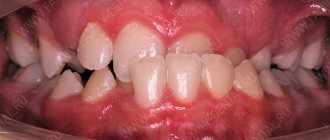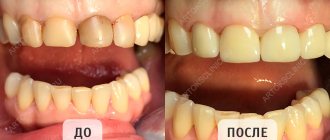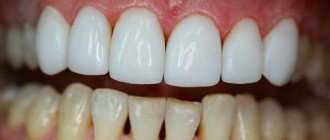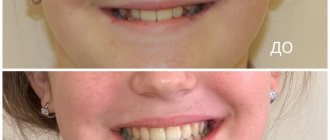Scientists have proven that a smiling person evokes more sympathy than even the most beautiful but gloomy top model. Moreover, employers are more loyal to those with healthy and beautiful teeth. Such people give the impression of being more responsible and efficient. And Dutch researchers claim that with a smile a person always looks younger than his age. How to achieve an ideal smile and what to do if nature has not endowed you with beautiful teeth, says Ilgam Vagifovich Mamedov, leading orthopedist and chief physician of the German Center for Aesthetic Dentistry SDent in Moscow.
The smile looks symmetrical
The basis of a beautiful smile is symmetry, that is, one half of the lips should be symmetrical to the other. When smiling, about 40 different facial muscles work, but they are all trained differently, which is why the smile often turns out to be asymmetrical.
Facial muscles can be trained with simple exercises (these exercises will not only make your smile perfect, but will also help avoid the appearance of facial wrinkles and improve diction).
- Purse your lips, pull them into a tube and hold them in this position for a few seconds. Then relax your lips. Repeat 5-8 times.
- Close your lips tightly, stretch them forward and try to make a figure eight with them. Then relax your muscles. Repeat the exercise 2-3 times.
- Stick out your tongue, clasp it tightly with your lips and hold this position for a few seconds, then relax the muscles of your lips and tongue as much as possible. Repeat five times.
- Stretch your lips into an unnaturally wide smile, and then relax them. Repeat five times.
Seven main violations when creating a smile design
Students and practitioners are increasingly turning to digital smile design techniques to directly demonstrate potential aesthetic changes to patients and healthcare team members (including dental technicians). The principles of smile design include studies of facial aesthetics, labiodental dynamics, gum and dentition architecture, as well as the phonetic component. To better explain to patients and demonstrate to their colleagues the dynamics of aesthetic changes in the smile, many doctors do a fantastic job of illustrating the principles of smile design in relation to the ideal state of harmony required, based on the individual anatomical features and physiological characteristics of each individual patient.
This approach is useful not only from a demonstration point of view, but also in terms of identifying possible violations that compromise the aesthetic appearance. Therefore, recommendations regarding the proper assessment and resolution of specific errors encountered during the smile design stage provide some guidance in the practice of aesthetic dentistry.
This article discusses seven main violations in the formation of design, as well as methods for assessing them and solving them to restore the ideal harmonious form.
1. Crooked smile
A crooked smile is an extremely noticeable violation not only for a dentist, but also for an ordinary person, like a crooked shelf on a flat wall. After restoration, few people additionally check the condition of the interincisal line, but it is this line that affects the visual inclination of the smile line relative to the vertical axis (photo 1 and photo 2). Straightening your smile requires developing a preliminary treatment plan that takes into account basic aesthetic principles. Among the aspects that definitely need to be examined: horizontal and vertical parameters of the face, including the line connecting the corners of the mouth, as well as the interpupillary horizontal line. A vertical line drawn through the middle of the face should be assessed in relation to the bridge of the nose, the tip of the nose and the middle of the chin. It is also important to ensure that the interincisal contact line is perpendicular to the absolute horizontal. To prevent a crooked smile, it is important to understand that the analysis of facial aesthetics should begin with studying the patient’s photograph, and in no case should it be reduced to the analysis of models (which is an extremely popular violation, taking into account the fact that even models in the majority are analyzed only on the subject of interest area of the jaw). When studying the planes of the face, it is necessary to take into account the patient’s characteristic horizontal position of the head, since it is largely the starting point for the further formation of the smile design. As a rule, this criterion in most cases coincides with the absolute horizontal plane, relative to which some facial features may have disturbances (as a consequence of the asymmetry effect). It is also important to analyze the facial area as a whole, and not concentrate on the position of only the area of interest relative to the horizontal plane. Restoring the horizontal plane is also an important aspect of collaboration with the dental technician using a facebow and wax-up (Photo 3 and Photo 4).
Photo 1. A comprehensive facial analysis before intervention is the key to treatment success. Changes in the interincisal angle, which may not be noticeable, can be detected through graphical analysis of photographs, which also facilitates collaboration with the laboratory when correcting a crooked smile (restorations made by IPS e.max and IPS Empress (Ivoclar Vivadent)
Photo 2. A comprehensive facial analysis before intervention is the key to treatment success. Changes in the interincisal angle, which may not be noticeable, can be detected through graphical analysis of photographs, which also facilitates collaboration with the laboratory when correcting a crooked smile (restorations made by IPS e.max and IPS Empress (Ivoclar Vivadent)
Photo 3. The use of a facebow and mock-up helps the dentist coordinate the dental technician regarding the required position of the incisal edges and interincisal line, which makes the final treatment results more predictable.
Photo 4. The use of a facebow and mock-up helps the dentist coordinate the dental technician regarding the required position of the incisal edges and interincisal line, which makes the final treatment results more predictable.
2. Reverse smile
Formation of a smile requires maintaining symmetry between the cutting edge of the anterior teeth of the upper jaw and the border of the lower lip following it (the principle of labiodental dynamics). Labiodental dynamics are formed from the cutting edge, where a convex line is created that extends into the area of the chewing teeth. The chewing teeth, as a rule, follow the level of the occlusal plane parallel to the Camper horizontal (from the nose to the tragus of the ear). The level of convexity depends on the patient’s gender, age, shape of the lower lip and individual characteristics. Straight smile lines are more common in men and older people, while more convex curves are more common in younger people and women. A reverse smile in the shape of a concave curve provokes an unaesthetic appearance of the cutting line, while creating the facial image of an “unhappy” person (photo 5). In order to ensure a “happy” smile, it is necessary to analyze in detail the length of the teeth and their relationship with the lips in a dynamic state. This approach will help you understand what is best to do: shorten the canines or lengthen the incisors to correct a concave smile. Although in the literature there are also recommendations that it is necessary to check the position of the fangs relative to the edge of the lips, since the type of incisors depends on too many factors: the shape and length of the lips, the length of the tooth and even the characteristics of lip movements. The results of recording the final position of the incisal edge are transferred to the laboratory before the stage of making the wax reproduction, because in this case it is possible to correct the length of the teeth and the convex shape of the smile, both using mock-up and using digital software (photo 6-8). The positions of the smile shape can be partially recorded using a face bow and models correctly plastered in the articulator, but to determine labiodental dynamics it is necessary to analyze photographs and videos of the patient.
Photo 5. With a reverse or concave smile, the line of the incisal edge of the teeth is not congruent with the border of the lower lip. Correcting the incisal line to a more convex shape ensures that the smile is symmetrical relative to the lower lip and creates a more aesthetic profile.
Photo 6. Before starting treatment, it is important to establish the final position of the incisal edge, taking into account the shape of the gingival margin and the ratio of the length and height of the crowns. Excessive elongation of teeth can cause the effect of narrow central incisors. The use of digital methods (for example, proportional shapes with specific width-to-height ratios) during the pre-planning stages will determine the required length of incisal edges, taking into account changes in the gingival margin. The final length of the incisors can also be double-checked on a mock-up before changing the gingival contour. The use of wax reproductions significantly reduces the time required to make provisional structures. The concave shape of the smile was restored to a more convex contour with IPS Empress restorations.
Photo 7. Before starting treatment, it is important to establish the final position of the incisal edge, taking into account the shape of the gingival margin and the ratio of the length and height of the crowns. Excessive elongation of teeth can cause the effect of narrow central incisors. The use of digital methods (for example, proportional shapes with specific width-to-height ratios) during the pre-planning stages will determine the required length of incisal edges, taking into account changes in the gingival margin. The final length of the incisors can also be double-checked on a mock-up before changing the gingival contour. The use of wax reproductions significantly reduces the time required to make provisional structures. The concave shape of the smile was restored to a more convex contour with IPS Empress restorations.
Photo 8. Before starting treatment, it is important to establish the final position of the incisal edge, taking into account the shape of the gingival margin and the ratio of the length and height of the crowns. Excessive elongation of teeth can cause the effect of narrow central incisors. The use of digital methods (for example, proportional shapes with specific width-to-height ratios) during the pre-planning stages will determine the required length of incisal edges, taking into account changes in the gingival margin. The final length of the incisors can also be double-checked on a mock-up before changing the gingival contour. The use of wax reproductions significantly reduces the time required to make provisional structures. The concave shape of the smile was restored to a more convex contour with IPS Empress restorations.
3. Social Six
Aesthetic violations of the front teeth (their color and shape) are much more difficult to correct than similar violations in the posterior area, since it is the front teeth that recreate the main appearance of the smile. Although the study of dentolabial width points to the fact that in most cases, 10 to 12 maxillary teeth are exposed when smiling, so smile correction needs to be carried out wider than the range of the social six (photo 9-11). To do this, before starting treatment, you need to study in detail photographs of the patient’s smile from the frontal and lateral views. Another principle of dentolabial dynamics (also known as buccal corridor or buccal width) is that the size of the space between the back teeth and cheek can vary from patient to patient, so this aspect is also equally important when contouring a smile. If the buccal corridor is quite narrow, then treating only the social six teeth further provokes a narrow appearance of the smile. In addition, such an approach to rehabilitation provokes the effect of highlighting the frontal teeth and their contrast in comparison with the chewing group. Conversely, restoration of the posterior teeth with some lightening can simulate a wider volume of cheek space, and thereby recreate a completely new and fuller smile contour. The right solution is to find a balance between these parameters. Again, before treatment, you need to analyze the nature of the smile, evaluate the color and contour of the existing back teeth. In addition, the relationship between the occlusal plane in the posterior region and the plane of the incisal edge must be taken into account. It is always necessary to take into account those treatment options in which it is possible not only to restore the smile with the help of individual restorations in the frontal group of teeth, but to adjust its contour in relation to the chewing teeth, while giving it a full appearance and aesthetic harmony.
Photo 9-11. Patients with excessive buccal space can improve the overall appearance of their smile due to problems with the anterior teeth only. On the contrary, a deficiency of the buccal corridor can compromise the treatment result through the effect of an artificial smile. Widening the smile from the anterior IPS e.max restorations to the directly restored premolars allows you to create the ideal oral width parameter.
4. Ignoring the proportions of the central incisor
The central incisors naturally dominate the smile, so incisor symmetry is of utmost importance to achieve optimal aesthetic contour. In addition, the proportion of each individual incisor also plays an equally important role. The Golden Ratio has traditionally been the reference principle for creating the perfect smile, but today artistic design is leaning towards less regimented approaches and individualized designs. The width-to-height ratio of unworn incisors is usually 80%. This proportion must be adhered to in order to avoid too long, narrow, or, on the contrary, too wide and excessively voluminous appearance of the front teeth. When correcting aesthetic length or width, or when deliberately altering incisors due to crowding, the most common effect is that the tooth is too long or too narrow compared to its actual width. With the loss of the central dominant, the sizes of the central and lateral incisors may appear similar, which creates an unaesthetic and artificial appearance of the smile. If the space for restoration of the central dominant is limited, you can slightly narrow the shape of the lateral incisors, or even rotate them slightly around their axis (photo 12 and photo 13). An effective principle is to support 65% of the width of the central incisors in the area of the lateral teeth, and, accordingly, 75% of the transverse width of the laterals in the area of the canines. The use of graphical proportion limiters in Keynote or PowerPoint and their positioning on top of the teeth image, or measuring the actual width and height of the crown in patients and calculating the ratios greatly facilitates the effect of visualizing a smile and promotes cooperation with the laboratory at the treatment planning stages.
Photo 12-13. Patients with excessive buccal space can improve the overall appearance of their smile due to problems with the anterior teeth only. On the contrary, a deficiency of the buccal corridor can compromise the treatment result through the effect of an artificial smile. Widening the smile from the anterior IPS e.max restorations to the directly restored premolars allows you to create the ideal oral width parameter.
5. Overly contoured teeth
There are three main tooth shapes: narrow, square and oval. All teeth also have reflective and refractive zones, separated by right angles. By manipulating these angles, it is possible to imitate a short and voluminous shape, a long and narrow appearance, or a more rectangular or curved tooth outline. The mesio- and distal-facial right angles are located on the facial surface closer to the contact area. Moving them outward from the contact pads creates a wider tooth appearance, while moving them toward the center imitates a narrower tooth shape. Without distinguishing between the reflective and refractive zones, teeth may appear overly contoured (Figure 14 and Figure 15). Since ceramists work in conditions created by the preparation stage, in which transition angles are reduced, they need to restore specific areas of the tooth using the ceramic itself as a veneering material. When preparing for veneers, you must carefully ensure that the tissue is adequately reduced relative to the contour of the final restorations at the mock-up stage. The depth of preparation should be appropriate mesio- and distofacially in all three planes to provide sufficient space to create esthetic reflective and refractive zones in these areas without thickening the shape of the entire tooth.
Photo 14-15. Teeth lacking visualization of final right angles appear overly contoured as the contour height parameter migrates in the facial direction. This problem is related to the design of the preparation. Preparation with mock-up allows you to achieve the ideal design. The use of wax reproduction helps to predict the result and make the necessary corrections before the fixation stage. The existing ceramic restorations on teeth 4-13 were replaced with IPS e.max restorations; teeth 20-29 were also restored.
6. Ignoring negative space
The space around a tooth determines its visual boundaries and the overall composition of the smile. When designing a smile, it is important to provide sufficient space for embrasures in the incisal area and interincisal angles in the incisal area. The width of the tooth and visual depth are determined by the area of the interdental contact areas, which for central incisors expand to the cutting edge and reduce the cutting angle. Tooth contact points migrate apically from the central incisors to the canines, thereby increasing the interincisal angles. As teeth wear down, the incisal angles decrease or disappear completely, creating a flat smile line and an aging effect. When restoring a smile, clinicians must recreate the natural progression of the interincisal angle, which in turn determines the morphology, appropriate tooth length, and convexity of the incisal curve. Incisal angles are also taken into account when preparing for construction to ensure that ceramists have enough room to restore negative space. These areas can be corrected after cementation using the proper tools (photos 16-19).
Photo 16-19. Loss of space between the incisors creates the appearance of an older smile. View before intervention: 38-year-old patient with signs of pathological abrasion due to bruxism. At the planning stage, a mock-up was made and proportions were determined to restore the ideal shape of the teeth. After installing IPS e.max restorations, the interdental spaces were restored, which made the appearance even more masculine; the parameters of durability, function and aesthetics were also optimized.
7. Gum asymmetry
The position of the gums is another important factor in determining smile design. The aesthetics of the gums influences the parameters of symmetry (identity of parameters relative to the vertical axis) and harmony (the criterion of repetition of relationship parameters), and is one of the key criteria at the treatment planning stage. However, restoring tooth length to recreate symmetry can disrupt the harmony of the smile, especially if the height and position of the gum margin were not taken into account when planning treatment. The position of the gum margin is especially important in people with medium to high smile lines. The smile line is also one of the parameters of labiodental dynamics, which determines the position of the lips during a smile (for example, 69% of people expose from 75% to 100% of the height of the central incisors along with the area of the interdental papilla when smiling). The gingival margins of the canines and central incisors should be symmetrical and positioned more apically than those of the lateral incisors. The gingival margin should gradually migrate towards the incisal area in the direction from the central to the lateral teeth. The rule is that the gum edge of the canines and central incisors should be in line, and the gums around the lateral teeth should be slightly closer to the incisal area, that is, the gingival edge line of the lateral incisors should be below a similar line connecting the gum edge of the central incisors and fangs (photo 20). Since the position of the gingival margin is determined by photographs and models correctly positioned relative to the horizontal line, there is a need for high-quality preoperative images. The optimal diagnostic analysis will help you choose the right treatment approach: whether to contour the gum area or get by with crown lengthening. Loss of soft tissue levels is most often observed in cases of poor surgical planning, so the use of surgical guides helps to more accurately control such changes. Assessing a smile together with the patient helps the doctor motivate the latter to perform specific procedures aimed at leveling factors that compromise the external aesthetic appearance. In addition, cooperation with the patient helps the doctor understand and satisfy specific individual wishes and achieve exactly the results that the patient, in principle, expects.
Figure 20: Gingival esthetics also play a key role in smile design, and understanding the ideal soft tissue parameters makes it easier to plan appropriate treatment, highlighting important points that need to be discussed with the patient prior to intervention. For ideal symmetry, it is important that the lateral incisors are more gingival to the line connecting the gingival margin of the central incisors and canines.
conclusions
Proper examination and treatment of patients with smile disorders helps to recreate the desired aesthetic appearance of the patient and achieve the maximum possible positive rehabilitation results. Continuous education in the basic principles of smile design will help you identify and understand the basic criteria that must be adhered to during treatment, and a discussion of the seven most common design mistakes will help you anticipate and avoid subsequent complications and disappointments in the final outcome of your rehabilitation.
Posted by Jason Olitsky, DMD, AAACD
The smile looks sincere
They say that stars have been training to smile correctly for years, and some have their smiles even “put on” by image specialists.
To independently find the very shape that suits you completely, you need to train in front of the mirror and, of course, visit the dentist at least once a year.
By the way, on the Internet there are many photographs of stars before the dentist has worked on them thoroughly. Believe me, their smiles were very far from ideal. Demi Moore once admitted that she invested more than $12,000 in her teeth.
However, nothing will help you if your smile is insincere and forced. A positive attitude, cheerfulness and openness to the world will make any smile irresistible.
Liv Tyler
Expand to full screen Back 1 / 5 Forward
Physiognomy - small lips in women and men: character
It used to be thought that thin lips were characteristic of stingy people, but in fact this is not the case.
Physiognomy - small lips in women and men, character:
- Thin, small lips, which are distinguished by a wide slit, indicate that a person always sees something bad in events. That is, he is a pessimist.
- In most cases, such lips are found in women and men who are distinguished by their gloomy and taciturn character.
- They don’t like to talk a lot, even in the company of friends it’s difficult to get a word out. Very often such lips indicate excessive tension, a person is not at ease.
small lips
Physiognomy - plump lips in women and men: character
Similar studies that connect character with facial features appeared a long time ago, back in the time of Aristotle. Since then, many have tried to connect a person’s character with the features of their eye shape, smile or face shape.
Physiognomy of plump lips in women and men, character:
- Now many companies that are engaged in sales are trying in every possible way to increase the sales of goods. That is why they also resort to the intricacies of physiognomy and its study. It has been proven that people with lush, brightly defined lips, even if they are not very large, can make decisions for quite a long time.
- They are not used to doing things rashly. Therefore, if you approach such a person in a store and begin to impose your help, he will most likely turn around and leave. Conversely, people with thin lips, which are practically invisible, are prone to analytical thinking and the implementation of certain algorithms.
- Such people rarely come to the store just to look and ask the price. Most of the time they come to buy. That is why it is much easier to persuade such a person to buy, and he will not think for long. This is not due to the fact that he makes a rash decision, but because of careful consideration when making purchases.
plump lips
Physiognomy - thin upper lip in women and men: character
If the mouth is asymmetrical, for example, one corner is higher or lower than the other, then you need to be careful with such people. The person is very kind and sympathetic, curious, and easy to win over.
Physiognomy - thin upper lip in women and men, character:
- Most of these people are pessimistic. They expect bad things from almost everyone and tend to become depressed. People who have very full, protruding lips have a capricious character and want to have fun.
- For the most part, such people do not want to do anything; they almost never have work. They spend a lot of time on self-admiration. Mostly such women become kept women.
- Men either drink themselves to death or find a woman who is ready to sponsor them. It is necessary that the person who is nearby takes care of them and provides for them.
Thin lips
Physiognomy - large lower lip in women and men: character
People don’t always have both large lips, or vice versa, thin ones. It happens that the upper lip is very thin, while the lower lip is quite plump.
Physiognomy of the large lower lip in women and men, character:
- Such people have a concentrated cocktail of emotions and an explosive mixture. They are usually quite hot-tempered. From people with lush lips they inherited a love of pleasure, sexuality, and emotionality.
- But the upper lip also affects the person as a whole. It is precisely because of their thin upper lip that they do not allow themselves to relax, and are often on the verge of making a mistake, but do not make it.
- Therefore, such people are very careful, although they are not averse to having fun. Physiognomists advise not to trust such people, as their mood often changes. They can be very stingy, or, on the contrary, they indulge in carnal pleasures and spend money at the speed of sound. This is not the best option for a partner; you need to be prepared for the unexpected.
plump lips
Where to start working on creating the perfect smile?
If you dream of a beautiful Hollywood smile, like celebrities from the screen and covers of glossy publications, then the first thing you should do is cure your teeth from caries, restore those elements of the dentition that are severely damaged or completely absent.
If those teeth that are included in the smile area are destroyed by more than 50%, it would be more correct to restore them not by filling with a composite material, but by installing crowns. Severely damaged teeth will need to be filled with large fillings, which do not have a high-quality and reliable fixation and can break and fall out under stress. In most cases, fillings break and fall out along with part of the tooth, and if the root part is also damaged, then the tooth will have to be removed and then restored with implantation.
In addition, even fillings made from high-quality materials darken and sag over time. These changes negatively affect the aesthetics of the teeth and will be clearly visible on the front teeth that fall into the smile area.
Installing crowns will help avoid such problems and, moreover, will significantly improve the aesthetics of the dentition. After all, when making a crown for you, the dentist can give the structure a correct and beautiful shape that fits into the standards of an ideal smile.
To create a Hollywood and beautiful smile, it is recommended to install ceramic crowns, because crowns made of this material:
- They have a high level of aesthetics. In terms of transparency and light transmission, dental ceramics are as close as possible to natural tooth enamel. Thanks to these characteristics, ceramic crowns look natural;
- Ceramics have sufficient strength to flawlessly withstand the load that occurs when chewing food;
- By placing ceramic crowns on your teeth to achieve a Hollywood smile, you will not encounter problems such as bluish gums or the appearance of a dark line at the edge of the gums in contact with the crown. These problems arise when inexpensive metal-ceramic crowns are used in the restoration of teeth in the smile area.
Naturally, before you begin dental treatment, in order to get a beautiful smile, you must undergo the procedure of oral sanitation and whitening. Beautiful teeth cannot be yellow and covered with plaque and tartar; in addition, sanitation and whitening will help you see the true shade of your enamel and choose the right materials for fillings and crowns.
How much does it cost to create a perfect smile?
The cost of creating a perfect, Hollywood smile is always an individual question. If your teeth are healthy, have a beautiful and even shape, without fillings, and your bite is correct, the cost of acquiring an ideal smile will be minimal; it will be enough for you to undergo professional teeth cleaning and whitening procedures.
The costs of creating an ideal smile will increase if you need prosthetic crowns or orthodontic treatment. The price for creating a beautiful smile will depend on the technology of prosthetics and the technique of bite correction.
If you want to get the smile of your dreams with the help of veneers, then you should know that usually these microprostheses are placed on all teeth included in the smile area. That is, veneers will need to cover 7-8 teeth in the upper jaw and the same number in the lower jaw. The price of one ceramic veneer will start at 35 thousand rubles; lumineers will cost more because they are produced not in Russia, but in the USA.
To find out what the exact price of an ideal smile will be for you, you need to visit the clinic and undergo an examination by several specialists at once - a therapist, an orthopedist and an orthodontist. For a beautiful and bright smile, we invite you to our clinic in Moscow - “Aesthetica”!
Physiognomy - short upper lip in women and men: character
The most unusual are the fair sex, who have a short upper lip. This structure is not very common, but the owners of such sponges are emotional, so they stand out among the crowd. They value themselves highly and often suffer from increased self-esteem. Uncompromising in achieving success and goals. These people will move mountains on their way to achieve success. They adapt well to any conditions and can find a way out.
Physiognomy - short upper lip in women and men, character:
- They change their minds infrequently, despite the fact that they can adapt. They often think about mistakes and correct them. People tend to be introspective and often study psychology. They do not achieve success in their personal life very often, because they are characterized by increased sensitivity and libido.
- They often have many affairs that end in failure. They are very easy to win over, they are trusting, which is why they often suffer. If the corners of the lips are raised upward, people are prone to various affairs. They never suffer from attention deficit disorder.
- It is believed that women with such lips are excellent lovers and are ready for sexual experiments. A man with such lips has a lot of girls, whom he changes quite often.
- The person is kind, sympathetic, but not constant. If the corners of the lips are not drawn, blurred, the person has a weak character. They are prone to manipulation and are easy to lure to their side and manipulate.
- Such people are very naive, which is why they suffer and get into various troubles. If the corners of the mouth are outlined, then the person is romantic, intellectual, and emotional. Such people love to analyze and never make frivolous decisions.
Beautiful lips
Physiognomy - large lips in women and men: character
Full, lush lips speak of sensuality and excessive sexuality.
Physiognomy of large lips in women and men, character:
- Almost all women dream of lips like these, so it’s no wonder plastic surgeons have a lot of work to do.
- Lately, lip augmentation procedures have become very popular. If your lips are natural, quite lush, full, this speaks of a sultry beauty who loves the attention of men.
- She tries in every possible way to attract men, often goes on a diet, does fitness and loves herself very much.
- Such women are the dream of men, but they are not very good housewives and wives. Such women love the attention of not one man, but several, so you shouldn’t count on loyalty.
Beautiful lips










